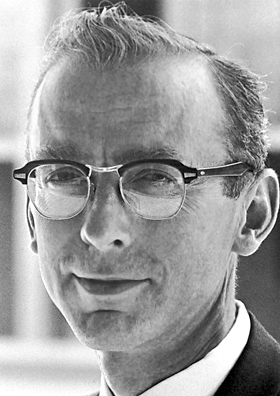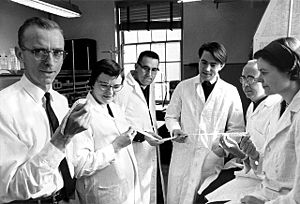Robert W. Holley facts for kids
Quick facts for kids
Robert W. Holley
|
|
|---|---|
 |
|
| Born |
Robert William Holley
January 28, 1922 |
| Died | February 11, 1993 (aged 71) |
| Nationality | American |
| Alma mater | University of Illinois at Urbana–Champaign Cornell University |
| Known for | Transfer RNA |
| Awards | Albert Lasker Award for Basic Medical Research (1965) NAS Award in Molecular Biology (1967) Nobel Prize in Physiology or Medicine (1968) |
| Scientific career | |
| Fields | Biochemistry |
| Institutions | Salk Institute for Biological Studies |
Robert William Holley (born January 28, 1922 – died February 11, 1993) was an American scientist who studied biochemistry. He won the Nobel Prize in Physiology or Medicine in 1968. He shared this important award with two other scientists, Har Gobind Khorana and Marshall Warren Nirenberg. They won for figuring out the structure of a special molecule called transfer RNA (tRNA). This discovery helped us understand how our bodies use DNA to make proteins.
Contents
Early Life and Education
Robert Holley was born in Urbana, Illinois. He finished high school there in 1938. He then went to the University of Illinois at Urbana-Champaign to study chemistry. He graduated in 1942. After that, he started working on his PhD degree. This advanced degree was in organic chemistry at Cornell University.
War Work and PhD
During World War II, Holley spent two years helping with important research. He worked with Professor Vincent du Vigneaud at Cornell University Medical College. There, he was part of the team that created penicillin in a lab for the first time. Penicillin is a very important medicine that fights infections. Holley finished his PhD studies in 1947.
Research and Discoveries
After getting his PhD, Holley stayed at Cornell University. He became an assistant professor of organic chemistry in 1948. Later, in 1962, he became a full professor of biochemistry. He started his research on RNA after spending a year (1955–1956) studying with James F. Bonner. This was at the California Institute of Technology.
Understanding Transfer RNA
Holley's research focused on a type of RNA called transfer RNA (tRNA). His goal was to find out its exact sequence and structure. Transfer RNA is a molecule that helps build proteins. It does this by bringing specific amino acids (the building blocks of proteins) to the right place.
Holley's team figured out the tRNA's structure using a clever method. They used two different enzymes called ribonucleases. These enzymes cut the tRNA molecule into smaller pieces at specific points. By carefully studying these pieces and comparing them, the team was able to put the puzzle together. They eventually figured out the entire structure of the molecule. A researcher named Elizabeth Beach Keller was part of this team. She developed the "cloverleaf model" that helps describe how transfer RNA looks.
A Nobel Prize Discovery
The full structure of tRNA was completed in 1964. This was a huge discovery! It was key to understanding how proteins are made from messenger RNA (mRNA). It was also the very first time anyone had figured out the full sequence of a ribonucleic acid molecule.
For this amazing discovery, Robert Holley received the Nobel Prize in Physiology or Medicine in 1968. Har Gobind Khorana and Marshall Warren Nirenberg also shared the prize that year. They were honored for their own important contributions to understanding how proteins are made in living things.
Impact of Holley's Method
After Holley's team showed how to find the structure of tRNA, other scientists used his method. They were able to figure out the structures of other tRNAs. A few years later, the method was changed a bit. It was then used to help track the sequence of building blocks in different viruses. This included viruses that affect bacteria, plants, and even humans.
Later Career and Interests
In 1968, Robert Holley moved to the Salk Institute for Biological Studies in La Jolla, California. He became a resident fellow there.
Outside of his scientific work, Holley enjoyed being outdoors. He also had a hobby as an amateur sculptor, creating art from bronze.
See also
 In Spanish: Robert W. Holley para niños
In Spanish: Robert W. Holley para niños
- History of RNA biology
- List of RNA biologists


